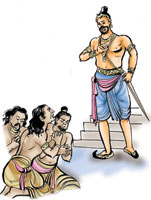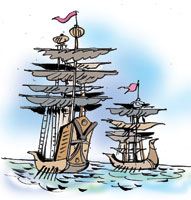1. To put down the Kandyan Rebellion, King Veera Parakramabahu VIII, went on conquering land up to Gadaladeniya. The rebel leader was Menavara Thunaya, the nephew of Dodanwela Parakrama Epa. He got frightened and pleaded for mercy from the king. The king was ready to pardon him. It's not only he, but a lot of other people from 'Kanda-Uda-Pas-Rata' received the king's pardon. Once things were settled, the king put up the Gadaladeniya inscription.
2. According to this inscription, Menavara Thunaya and his crowd were to abstain from
issuing coins, trade in
elephants or even riding elephants. It further states that they swore by the Sacred Tooth Relic and promised to be supportive of the king. According to the account in Rajavaliya, King Veera Parakramabahu VIII had four sons by his chief queen. They were namely, Dharma Parakramabahu, Vijayaratne, Rajasingha and Raigam Bandara.
3. The king got married to the chief queen's sister too. She also bore two sons for the king and they were named Sakala-Kala-Vallabha and Thaniya-Vallabha. Of the two, Sakala-Kala-Vallabha made Udugampola his kingdom and Thaniya lived in Katupiti Madampe. During this time, there was a Muslim national named 'Kadirayana,' who was engaged in diving for pearls and plundering elephants in the Chilaw area. He used to have an army of his own.
4. Thaniya-Vallabha and Sakala-Kala-Vallabha went with their armies to fight him. They fought with the Muslim leader and got him killed there. Once he was done away with, peace was restored to that area. In the meantime, King Veera Parakramabahu VIII, continued with the policies adopted by his father. His father had
conducted an alms giving for the Brahmins and it had been named 'Agra Ahara.' King Veera Parakramabahu too
continued it.
5. He donated the
village named Koswinna in Siyane Korale, for the
conducting of this
alms-giving. It is said that 'Kudu-Mirissa' Sannasa was proclaimed of this
purpose. This king issued a royal order, requesting the government officials, not to interfere with the lands that were inherited by the Venerable Keragala Vanarathana Thera, as they had come down for ten generations.
In 1501 AD, the king got the Keragala inscription written.
6. In the 19th year of rule of this king, that is in 1509 AD, Kelani Vihara had been renovated. Land was also donated for the upkeep of the temple. It is for this purpose that the Kelani Pillar inscription was erected. According to Dr. Senarath Paranavithana, this inscription is the work of King Dharma Parakramabahu IX. But this theory is being rejected by Dr. Mendis Rohanadeera.
7. During the reign of King Veera Parakramabahu, there was a notable foreign invasion. In 1505 AD, a powerful European nation, the Portuguese invaded our country.
The Portuguese, under Lorenzo de Almeida, had landed in Galle, according to what is said in the Portuguese records. But Rajavaliya (A.V. Suraweera edition) records the year as 1522 AD).
8. However, things said in the Rajavaliya about King Dharma Parakramabahu and the Portuguese cannot be taken as correct. Most scholars do not agree with it.
During this time, King Thaniya-Vallabha lived in Madampe. He had a
daughter named Samudra Devi, who was also called 'Princess Kapuru Lamaetheni.' She had two sons, who became very important personalities in Sri Lankan history.
|



